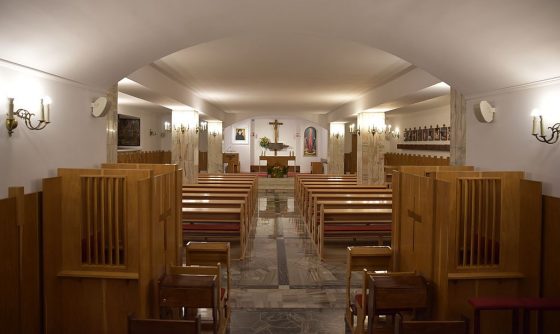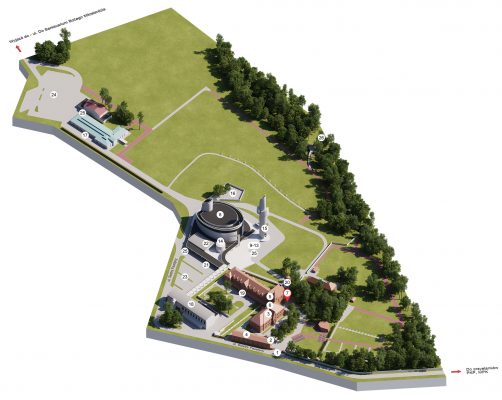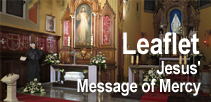We have put a map of the Shrine after the text.
Now we are in front of the Chapel of the Lord’s Passion, which is below the Chapel of the Merciful Jesus. Earlier this was just a small crypt to accommodate the bodies of deceased Sisters prior to the funeral. Sister Faustina was laid out here, too. It was converted into a chapel in 1986, and is now used by the Sisters and groups coming for retreats. In the chancel there is a cross with a tabernacle below with the words of the Chaplet, “Have mercy on us and the whole world.” The cross is flanked on either side by a picture of the Virgin Mary and St. Faustina. The Stations of the Cross (by Maria Konarzewska) run along the east wall. The mystery of Jesus’ Passion is also presented in a set of stained-glass windows designed by Wiktor Ostrzałek. All the interior decorations ‒ the stained glass, the Stations of the Cross, and the cross in the chancel ‒ depict Jesus’ Passion.
This is the chapel in which the custom started of the Community of the Łagiewniki Shrine praying at the Hour of Mercy and reciting the Chaplet jointly with pilgrims. Nowadays this service is broadcast from Łagiewniki on radio and television, attracting a global congregation of millions all praying at the same time in various languages, and begging God to “have mercy on us and the whole world.”
The Chaplet of the Divine Mercy, which Jesus dictated to Sister Faustina in Polish in Vilnius in 1935, is the second prayer (after the Paternoster) which Jesus taught us Himself. It is addressed to the Heavenly Father, to Whom, on the strength of the universal priesthood of all believers, we offer up “the Body and Blood, Soul and Divinity” of His Dearly Beloved Son “in atonement for our sins and those of the whole world.” Thereby, on the strength of their participation in the universal priesthood of Jesus Christ, the faithful join the priest in spirit in what he effects sacramentally on the altar. In this prayer they invoke the most powerful argument, offering Jesus up to His Father, which makes this prayer exceptionally effective, providing it is said in a spirit of trustfulness.
Jesus promised all who said the Chaplet of the Divine Mercy in a spirit of trust to grant them whatever graces they asked for and temporal blessings providing they complied with His will, along with the graces they will need at the hour of death. This means the grace of a happy death, one in which we choose to be with God for all eternity, and a quiet death, departing from this world free from fear and horror. These graces may be obtained not only personally by those who say the Chaplet in a spirit of trust, but also the dying at whose side others will pray the Chaplet on their behalf. Jesus promised that “anyone who says the Chaplet just once, even should he be the most hardened of sinners, shall receive grace from My infinite mercy” (Diary 687). Just once, but in the spirit of this prayer, that is with faith, contrition for all the wrong one has done, and with the intention to do the will of God. Saying this prayer is an act of mercy in itself, because in it we are asking for God’s mercy “on us,” that is those who are saying the prayer, for those we are praying for and are obliged to pray for, as well as “for the whole world,” in other words for all the people living on Earth and for the Souls in Purgatory. In Poland you can obtain a plenary indulgence on the ordinary conditions every day by saying the Chaplet of the Divine Mercy in front of the Blessed Sacrament.
In front of the Chapel of the Lord’s Passion, next to the Statue of the Merciful Jesus (by Czesław Dźwigaj) and St. Faustina (by the same artist) there is a quiet corner for a rest and reflection on the mystery of Divine mercy. People who discover God’s merciful live in their personal life, and in the lives of their family and country find that this most beautiful mystery of our faith brings substantial fruit in the existential and spiritual dimension, leading them to an ever deeper trustfulness in God and an active love of their neighbour.
- Main entrance to the Shrine
- Sister Faustina’s House: hotel & museum
- Convent
- Antoninek House: Faustinum Association
-
Merciful Jesus Chapel & Saint Faustina’s Tomb: Heart of the Shrine
- Oratory: room where Saint Faustina died
- Chapel of the Lord’s Passion
- Divine Mercy Basilica
- Saint Faustina’s Chapel
- The Communio Sanctorum Chapel
- Saint Andrew’s Chapel
- The Holy Cross Chapel
- The Chapel of Our Lady of the Seven Sorrows
- Perpetual Adoration Chapel
- Viewing Tower
- Convent Graveyard
- Sister Faustina’s House: restaurant, souvenirs & meeting hall
- Pastoral Lodge: hotel & restaurant
- Mercy House
- Information Booth
- Souvenirs & Misericordia Bookshop
- Saint John Paul II Hall
- Car park
- Car and coach park
- Toilets
- Bridge of Mercy, for the Saint John Paul II Shrine & tram stop

















